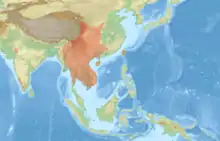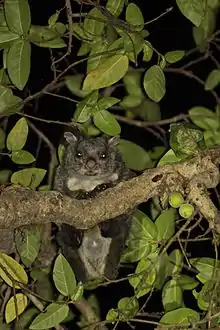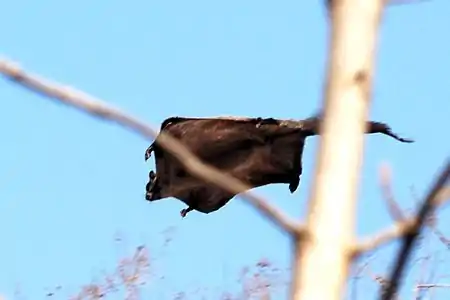Indian giant flying squirrel
The Indian giant flying squirrel (Petaurista philippensis), also called the large brown flying squirrel or the common giant flying squirrel, is a species of rodent in the family Sciuridae. It is capable of gliding flight using a skin membrane stretched between front and hind legs. It is found in mainland Southeast and South Asia, and southern and central China.
| Indian giant flying squirrel | |
|---|---|
 | |
| Scientific classification | |
| Kingdom: | Animalia |
| Phylum: | Chordata |
| Class: | Mammalia |
| Order: | Rodentia |
| Family: | Sciuridae |
| Genus: | Petaurista |
| Species: | P. philippensis |
| Binomial name | |
| Petaurista philippensis (Elliot, 1839) | |
 | |
| Range in red as reported by the IUCN, but see text | |
Description

This is a large species, with a head and body length of about 43 cm and a tail of 50–52 cm. It has black to gray-brown fur, long and soft on the upper parts and somewhat shorter underneath the body, with a grizzled appearance. A wing membrane between the forelimb and hindlimb, paler coloured underneath, allows gliding between trees. The tail is hairy and blackish to gray-brown, the feet are black, and the nose is pale pink with black vibrissae.[2]
Taxonomy
Its taxonomy is very complex and not fully resolved. Up until the 1980s, some authorities even listed the Indian giant flying squirrel itself as a subspecies of the red giant flying squirrel (P. petaurista).[3] In 2005, Mammal Species of the World included grandis, yunanensis, hainana, nigra, rubicundus and rufipes (last four as synonyms of yunanensis) in the Indian giant flying squirrel.[4] Later studies have confirmed that all these are distinct and not closely related to the Indian giant flying squirrel; placing them together would result in a strongly polyphyletic "species".[5][6][7][8] As a consequence, recent authorities have generally recognized them as part of the red giant flying squirrel or as their own species; the Formosan giant flying squirrel (P. grandis) of Taiwan, Hainan giant flying squirrel (P. hainana) of Hainan, and Yunnan giant flying squirrel (P. yunanensis) in northeastern India, south-central China, Myanmar, northern Laos and northern Vietnam (the extent of its range in the last three countries is labelled with considerable uncertainty).[3][9][10] The Formosan and Hainan giant flying squirrels have fully separate ranges, but the Yunnan giant flying squirrel is sympatric with the Indian giant flying squirrel.[6][9]
Distribution, habitat and taxonomy

The species is native to China, India, Laos, Myanmar, Sri Lanka, Taiwan, Thailand, and Vietnam. It inhabits dry deciduous and evergreen forest, usually at higher elevations from 500–2,000 m (1,600–6,600 ft) and has been recorded on plantations.[1]
Ecology
The Indian giant flying squirrel is nocturnal and arboreal, spending most of its life in the canopy. Nests are made in tree hollows lined with bark, fur, moss, and leaves. The species is sociable when food is abundant, but intraspecies attacks increase with food scarcity. Vocalizations are similar to those of the spot-bellied eagle-owl.[2]
Diet
The species is mainly frugivorous, preferring the fruits of Ficus racemosa, followed by Cullenia and Artocarpus heterophyllus. It also takes bark, tree resins, shoots, leaves (particularly of F. racemosa), insects, and larvae. Squirrels were shown to be somewhat tolerant of disturbance when foraging, and to exploit food resources at the forest edge, including exotic planted species.[11]
Reproduction
Female gives birth to a single offspring during mid June. Pups born blind, with a head that is disproportionately large when compared with the body.[2]
References
- Walston, J., Duckworth, J.W. & Molur, S. (2016). "Petaurista philippensis (errata version published in 2020)". IUCN Red List of Threatened Species. 2016: e.T16724A184098981. doi:10.2305/IUCN.UK.2016-3.RLTS.T16724A184098981.en.CS1 maint: uses authors parameter (link)
- Yapa, A.; Ratnavira, G. (2013). Mammals of Sri Lanka. Colombo: Field Ornithology Group of Sri Lanka. p. 1012. ISBN 978-955-8576-32-8.
- Jackson, S.M.; R.W. Thorington Jr. (2012). "Gliding Mammals – Taxonomy of Living and Extinct Species". Smithsonian Contributions to Zoology. 638: 1–117.
- Thorington, R.W., Jr.; Hoffman, R.S. (2005). "Species Petaurista philippensis". In Wilson, D.E.; Reeder, D.M (eds.). Mammal Species of the World: A Taxonomic and Geographic Reference (3rd ed.). Johns Hopkins University Press. pp. 754–818. ISBN 978-0-8018-8221-0. OCLC 62265494.
- Oshida, T.; C.M. Shafique; S. Barkati; Y. Fujita; L.-K. Lin; R. Masuda (2004). "A Preliminary Study on Molecular Phylogeny of Giant Flying Squirrels, Genus Petaurista (Rodentia, Sciuraidae) Based on Mitochondrial Cytochrome b Sequences". Russian Journal Theriology. 3 (1): 15–24.
- Yu, F.R.; F.H. Yu; J.F. Peng; C.W. Kilpatrick; P.M. McGuire; Y.X. Wang; S.Q. Lu; C.A. Woods (2006). "Phylogeny and biogeography of the Petaurista philippensis complex (Rodentia: Sciuridae), inter- and intraspecific relationships inferred from molecular and morphometric analysis". Mol. Phylogenet. Evol. 38: 755–766. doi:10.1016/j.ympev.2005.12.002.
- Oshida, T.; et al. (2010). "Phylogenetics of Petaurista in light of specimens collected from northern Vietnam". Mammal Study. 35: 85–91. doi:10.3106/041.035.0107.
- Li, S.; K. He; F.-H. Yu; Q.-S. Yang (2013). "Molecular Phylogeny and Biogeography of Petaurista Inferred from the Cytochrome b Gene, with Implications for the Taxonomic Status of P. caniceps, P. marica and P. sybilla". PLoS ONE. 8 (7): e70461. doi:10.1371/journal.pone.0070461.
- Jackson, S.M. (2012). Gliding Mammals of the World. CSIRO Publishing. pp. 112–135. ISBN 9780643092600.
- Francis, C.M. (2019). A Guide to the Mammals of Southeast Asia (2 ed.). New Holland Publishers. pp. 164–165, 362–363. ISBN 978-1-4729-3497-0.
- Nandini, R.; Parthasarathy, N. (2008). "Food habits of the Indian giant flying squirrel (Petaurista philippensis) in a rain forest fragment, Western Ghats". Journal of Mammalogy. 89 (6): 1550–1556. doi:10.1644/08-mamm-a-063.1.
Further reading
- Koli, VK.; Bhatnagar, C; Mali, D. (2011). "Gliding behaviour of Indian Giant Flying Squirrel Petaurista philippensis Elliot" (PDF). Current Science. 100 (10): 1563–1568.
- Nandini, R.; Parthasarathy, N. (2008). "Food habits of the Indian Giant Flying Squirrel (Petaurista philippensis) in rain forest fragment, Western Ghats" (PDF). J. Mammal. 89 (6): 1550–1556. doi:10.1644/08-mamm-a-063.1.
- Koli, VK.; Bhatnagar, C; Sharma, S.K. (2013). "Distribution and status of Indian Giant Flying Squirrel (Petaurista philippensis Elliot) in Rajasthan, India". Natl. Acad. Sci. Lett. 36 (1): 27–33. doi:10.1007/s40009-012-0105-z.
